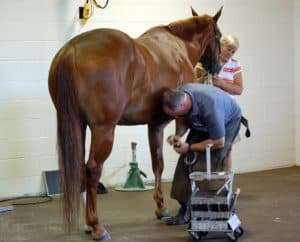Each year, the British Equine Veterinary Association (BEVA) hosts Europe’s largest equine veterinary conference. An international panel of world-renowned researchers and veterinarians present more than 90 hours of sessions on cutting-edge horse health topics. At the 2018 BEVA Congress, held in Birmingham, U.K., in September, experts covered topics ranging from lameness to infectious disease to performance horse injuries and much more. The Horse was in attendance to cover the most important take-homes for horse owners.
Equine Foot Lameness
Therapeutic Shoeing for Horses With Orthopedic Injuries: Six Key Points
Given the link between the external shape of the hoof capsule and its internal function, trimming and shoeing should optimize functionality and ultimately reduce stress, both to prevent injury and to treat established pathology, one veterinarian says. Read Now
Bisphosphonates for Managing Navicular Lameness in Horses
Since hitting the commercial equine market four years ago, bisphosphonates have been used primarily to manage horses with navicular disease. One veterinarian describes how they impact navicular region pain and lameness. Read Now
Brought to you by:







